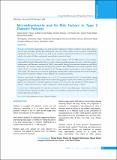Please use this identifier to cite or link to this item:
https://hdl.handle.net/20.500.14356/1435| Title: | Microalbuminuria and Its Risk Factors in Type 2 Diabetic Patients |
| Authors: | Thakur, Sanjay Kumar Dhakal, Sukesh Purush Parajuli, Shreeya Sah, Anil Kumar Nepal, Suresh Prasad Paudel, Bishnu Dutta |
| Citation: | ThakurS. K., DhakalS. P., ParajuliS., SahA. K., NepalS. P., & PaudelB. D. (2019). Microalbuminuria and Its Risk Factors in Type 2 Diabetic Patients. Journal of Nepal Health Research Council, 17(01), 61-65. https://doi.org/10.33314/jnhrc.v17i01.1620 |
| Issue Date: | 2019 |
| Publisher: | Nepal Health Research Council |
| Article Type: | Original Article |
| Keywords: | Mellitus Microalbuminuria Type 2 diabetes |
| Series/Report no.: | Jan-March, 2019;1620 |
| Abstract: | Abstract Background: Diabetic nephropathy is one of the dreaded complications of diabetes leading to chronic kidney disease and end stage renal failure globally. Microalbuminuria is the most sensitive marker of early recognition of the diabetic nephropathy. This study was carried out to find out the prevalence and potential risk factors of microalbuminuria which is the marker of diabetic nephropathy among diabetes patients in Nepal. Methods: A cross-sectional study was conducted on a random sample of 227 in T2DM patients in private diabetic clinics and Bir hospital in Kathmandu. Data were collected using standard questionnaire format to collect demography, anthropometry, and laboratory assessment of, HbA1c, post prandial, fasting glucose and micro albumin in urine. Micro albuminuria was measured using early morning urine specimen. Micro albuminuria was considered positive when urinary albumin to creatinine ratio was found to be 30–300 mg/g creatinine in preferably an early morning or a spot urine sample. The entire lab test will be done by applying the internationally accepted standards of tools and techniques.Those that were reported >30mg/mL of micro albumin were considered as positive. Results: Out of total 217 diabetic patients, 56.2% (122/217) were male and 43.8% (95/217) were female. Among all age groups, maximum patients enrolled were between the age group 41 to 80 (95%).Of the total, 20% (44/217)) patientswereMA positive. A statistical significant association was seen between MA and BMI (p=0.029), duration of DM (p=<0.001, hypertension (p=<0.001, smoking (p=<0.001) and physical activity (p=<0.001). Conclusions: Diabetic patients in Nepal have prevalence of 20.3% microalbuminurea. Hypertension, obesity, sedentary lifestyles, duration more than 5 years of illness are found the most important risk factors for the development of microalbuminurea in diabetes. Keywords: Mellitus; microalbuminuria; type 2 diabetes |
| Description: | Original Article |
| URI: | http://103.69.126.140:8080/handle/20.500.14356/1435 |
| ISSN: | Print ISSN: 1727-5482; Online ISSN: 1999-6217 |
| Appears in Collections: | Vol. 17 No. 1 Issue 42 Jan - Mar 2019 |
Files in This Item:
| File | Description | Size | Format | |
|---|---|---|---|---|
| 1620-Manuscript-9546-1-10-20190513.pdf | Fulltext Download | 189.61 kB | Adobe PDF |  View/Open |
Items in DSpace are protected by copyright, with all rights reserved, unless otherwise indicated.
